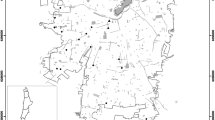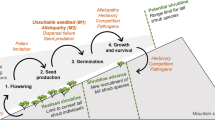Abstract
Previous studies report that the low colonisation success on eroded roadslopes of semiarid environments is controlled by microsite limitations. We predicted that soil water availability, through its effect on seed germination, is a determinant factor in the colonisation process of roadslopes in semiarid environments. Moreover, we predicted that the success of species establishment on the harshest roadslope conditions (i.e., south-facing roadcuts) is either due to the ability of seeds to germinate fast at low water potentials (colonising species) or to the ability of plants to sprout (resistant species). Specifically we present evidence for: (1) soil drying occurs faster on roadcuts than on roadfills after a rainfall event; (2) germination is a filtering process that influences the success of species establishment on roadslopes; (3) species able to colonise successfully south-facing roadcuts have higher germination rates and a shorter time to germination under water-stress conditions than species able to colonise successfully but exclusively the most favourable roadslopes (i.e., roadfills); (4) species that live on south-facing roadcuts and have the ability to sprout do not necessarily germinate with germinating rates and speeds as high as species that colonise successfully these slopes but are unable to sprout. To test these hypotheses we compared water dynamics in the soil among roadslope types and aspects as well as the seed ability to germinate at low water potentials among species showing different regeneration strategies and establishment success on roadslopes. Soil water availability after rainfalls occurring during the germination period played a major role in the germination of seeds. The patterns of seed germination under water-stress conditions were consistent with the success of colonising species on roadslopes and with the distribution of adult plants in the roadslopes 8 years after these latter were built. We discuss the usefulness of these results for the improvement of revegetation projects in semiarid areas by means of an appropriate selection of species adapted to the local environmental conditions. We suggest that the ability of species to germinate under water stress could be an indication of a species’ potential for success under semiarid conditions.



Similar content being viewed by others
References
Alborch B, García-Fayos P, Bochet E (2003) Estimación de los filtros ecológicos que controlan la colonización de taludes de carretera a partir del estudio del banco de semillas del suelo. Ecología 17:65–75
Atwell BJ (1993) Response of roots to mechanical impedance. Environ Exp Bot 33:27–40
Bellingham PJ (2000) Resprouting as a life history strategy in woody plant communities. Oikos 89:409–416
Bochet E, García-Fayos P (2004) Factors controlling vegetation establishment and water erosion on motorway slopes in Valencia, Spain. Restor Ecol 12:166–174
Bochet E, García-Fayos P, Tormo J (2007) Road slope revegetation in semiarid Mediterranean environments. Part I: seed dispersal and spontaneous colonization. Restor Ecol 15:88–96
Bond WJ, Midgley JJ (2001) Ecology of sprouting in woody plants: the persistence niche. Trends Ecol Evol 16:45–51
Bond WJ, Midgley JJ (2003) The evolutionary ecology of sprouting in woody plants. Int J Plant Sci 164:103–114
Briedé JW, Mckell CM (1992) Germination of 7 perennial arid land species, subjected to soil-moisture stress. J Arid Environ 23:263–270
Bruand A, Duval O, Galliard H, Darthout R, Jamagne M (1996) Variabilité des propriétés de rétention en eau des sols: importance de la densité apparente. Étude Gestion des Sols 3:27–40
Butaye J, Jacquemin H, Honnay O, Hermy M (2002) The species pool concept applied to forests in a fragmented landscape: dispersal limitation versus habitat limitation. J Veg Sci 13:27–34
Chaieb M, Floret C, Lefloch E, Pontanier R (1992) Life-history strategies and water-resource allocation in 5 pasture species of the Tunisian Arid Zone. Arid Soil Res Rehabil 6:1–10
Ericksson O, Ehrlén J (1992) Seed and microsite limitation of recruitment in plant populations. Oecologia 91:360–364
Estarlich M, Hernández AJ, Pastor J (1992) Conocimiento de ecotipos en especies fijadoras en taludes de carretera en clima semiárido. In: III Simposio Nacional sobre Taludes y Laderas Inestables. La Coruña, España
Evans CE, Etherington JR (1990) The effect of soil-water potential on seed-germination of some British plants. New Phytol 115:539–548
Flores J, Briones O (2001) Plant life-form and germination in a Mexican inter-tropical desert: effects of soil water potential and temperature. J Arid Environ 47:485–497
Foster BL, Tilman D (2003) Seed limitation and the regulation of community structure in oak savanna grassland. J Ecol 91:999–1007
García E (1996) Estudio florístico y fitogeográfico de la comarca de la Plana de Utiel-Requena (Valencia). PhD thesis, Universidad de Valencia, Spain
García-Fayos P, Recatala TM, Cerdà A, Calvo A (1995) Seed population-dynamics on badland slopes in Southeastern Spain. J Veg Sci 6:691–696
García-Fayos P, García-Ventoso B, Cerdà A (2000) Limitations to plant establishment on eroded slopes in southeastern Spain. J Veg Sci 11:77–86
Guerrero-Campo J, Palacio S, Pérez-Rontome C, Montserrat-Martí G (2006) Effect of root system morphology on root-sprouting and shoot-rooting abilities in 123 plant species from eroded lands in north-east Spain. Ann Bot 98:439–447
Ingelmo F, Villalba M, Pomares F (1998) Retención de agua en suelos cítricos con manejo ecológico y con manejo convencional. Modelos de regresión. In: Actas del III Congreso de la Sociedad Española de Agricultura Ecológica SEAE. Una alternativa para el mundo rural del tercer milenio, pp 215–222
Iwasa Y, Kubo T (1997) Optimal size of storage for recovery after unpredictable disturbances. Evol Ecol 11:41–65
Jurado E, Westoby M (1992) Germination biology of selected central Australian plants. Aust J Ecol 17:341–348
Kirmer A, Mahn EG (2001) Spontaneous and initiated succession on unvegetated slopes in the abandoned lignite-mining area of Goitsche, Germany. Appl Veg Sci 4:19–27
Klute A (1986) Water retention: laboratory methods. In: Methods of soil analysis, Part 1. Physical and mineralogical method. Agronomy monograph no. 9. American Society of Agronomy-Soil Science Society of America, Madison, USA, pp 635–662
Kutiel P, Lavee H (1999) Effect of slope aspect on soil and vegetation properties along an aridity transect. Israel J Plant Sci 47:169–178
Lu P, Sang WG, Ma KP (2006) Effects of environmental factors on germination and emergence of Crofton weed (Eupatorium adenophorum). Weed Sci 54:452–457
Matesanz S, Valladares F, Tena D, Costa-Tenorio M, Boté D (2006) Early dynamics of plant communities in revegetated motorway slopes from Southern Spain: is hydroseeding always needed? Restor Ecol 14:297–307
Michel BE, Wiggins OK, Outlaw WH (1983) A guide to establishing water potential of aqueous two-phase solutions (Polyethylene glycol plus Dextran) by amendment with mannitol. Plant Physiol 72:60–65
Midgley JJ (1996) Why the world’s vegetation is not totally dominated by resprouting plants; because resprouters are shorter than reseeders. Ecography 19:92–95
Montesinos D, Verdú M, García-Fayos P (2007) Moms are better nurses than dads: gender biased self-facilitation in a dioecious Juniperus tree. J Veg Sci 18:271–280
Neil KL, Tiller RL, Faeth SH (2003) Big sacaton and endophyte-infected Arizona fescue germination under water stress. J Range Manage 56:616–622
Novák J, Prach K (2003) Vegetation succession in basalt quarries: pattern on a landscape scale. Appl Veg Sci 6:111–116
Ojeda F (1998) Biogeography of seeder and resprouter Erica species in the Cape Floristic Region—where are the resprouters? Biol J Linn Soc 63:331–347
Pausas JG, Verdú M (2005) Plant persistence traits in fire-prone ecosystems of the Mediterranean basin: a phylogenetic approach. Oikos 109:196–202
Pérez AJ (1994) Atlas Climàtic de la Comunitat Valenciana (1961–1990). Consellería d’Obres Publiques, Urbanisme i Transports, Valencia, Spain, pp. 208
Potter RL, Ueckert DN, Petersen JL, Mcfarland ML (1986) Germination of fourwing saltbush seeds—interaction of temperature, osmotic potential, and pH. J Range Manage 39:43–46
Primack RB, Miao SI (1992) Dispersal can limit local plant distribution. Conserv Biol 6:513–519
Puech S, Rascol JP, Michel V, Andary C (1998) Cytogenetics and adaptation to increasingly arid environments: the example of Plantago albicans L. (Plantaginaceae). Biochem Syst Ecol 26:267–283
Roundy BA, Abbott LB, Livingston M (1997) Surface soil water loss after summer rainfall in a semidesert grassland. Arid Soil Res Rehabil 11:49–62
Sakai A, Sakai S, Akiyama F (1997) Do sprouting tree species on erosion-prone sites carry large reserves of resources? Ann Bot 79:625–630
Schupp EW (1995) Seed seedling conflicts, habitat choice, and patterns of plant recruitment. Am J Bot 82:399–409
Schütz W, Milberg P, Lamont BB (2002) Germination requirements and seedling responses to water availability and soil type in four eucalypt species. Acta Oecol 23:23–30
Snyder KA, Tartowski SL (2006) Multi-scale temporal variation in water availability: implications for vegetation dynamics in arid and semi-arid ecosystems. J Arid Environ 65:219–234
Sternberg M, Shoshany M (2001) Influence of slope aspect on Mediterranean woody formations: comparison of a semiarid and an arid site in Israel. Ecol Res 16:335–345
Tofts R, Silvertown J (2002) Community assembly from the local species pool: an experimental study using congeneric species pairs. J Ecol 90:385–393
Tolosa V (2001) Evaluación de la eficacia de la revegetación de taludes de obras públicas en ambientes mediterráneos secos. El caso de la variante Gilet—Soneja, Proyecto Fin de Carrera, Escola Politècnica Superior de Gandia, Universitat Politècnica de València, València
Tormo J, Bochet E, Gacía-Fayos P (2006) Is seed availability enough to ensure colonization success? An experimental study in road embankments. Ecol Eng 26:224–230
Turnbull LA, Crawley MJ, Rees M (2000) Are plant populations seed-limited? A review of seed sowing experiments. Oikos 88:225–238
Verheyen K, Hermy M (2001) The relative importance of dispersal limitation of vascular plants in secondary forest succession in Muizen Forest. Belgium J Ecol 89:829–840
Vesk PA, Westoby M (2004) Sprouting ability across diverse disturbances and vegetation types worldwide. J Ecol 92:310–320
Zobel M, van der Maarel E, Dupré C (1998) Species pool: the concept, its determination and significance for community restoration. Appl Veg Sci 1:55–66
Acknowledgements
This research was supported by the Ministerio de Ciencia y Tecnología (project REN2001-2313 and Programa Ramón y Cajal). We thank José Antonio Bellido for help with seed harvesting and cleaning. We are grateful to Jorge Sellés for assistance in retention curve determination and germination experiments. We acknowledge the Department of “Demarcación de Carreteras del Estado en Valencia del Ministerio de Fomento” for providing data on roadslope building. Two anonymous referees helped to improve this manuscript.
Author information
Authors and Affiliations
Corresponding author
Additional information
Responsible Editor: John McPherson Cheeseman.
Rights and permissions
About this article
Cite this article
Bochet, E., García-Fayos , P., Alborch, B. et al. Soil water availability effects on seed germination account for species segregation in semiarid roadslopes. Plant Soil 295, 179–191 (2007). https://doi.org/10.1007/s11104-007-9274-9
Received:
Accepted:
Published:
Issue Date:
DOI: https://doi.org/10.1007/s11104-007-9274-9




